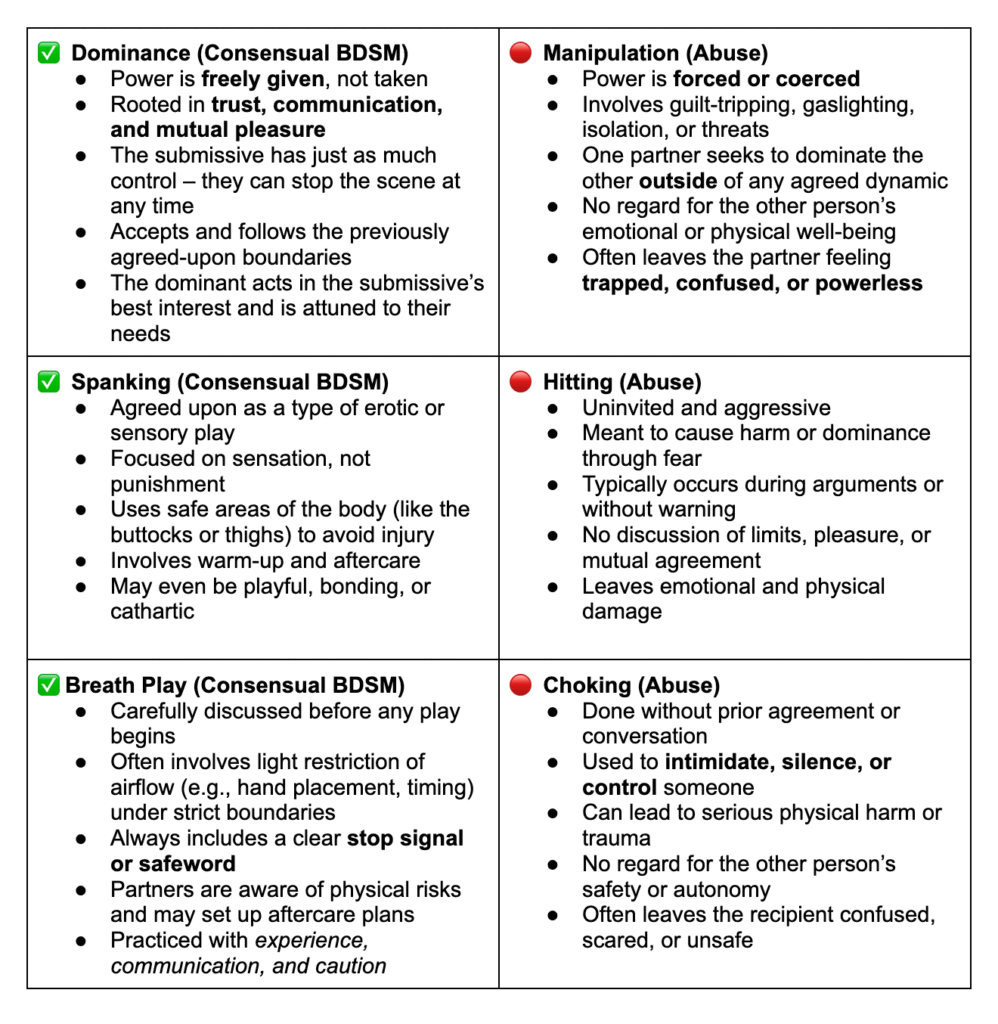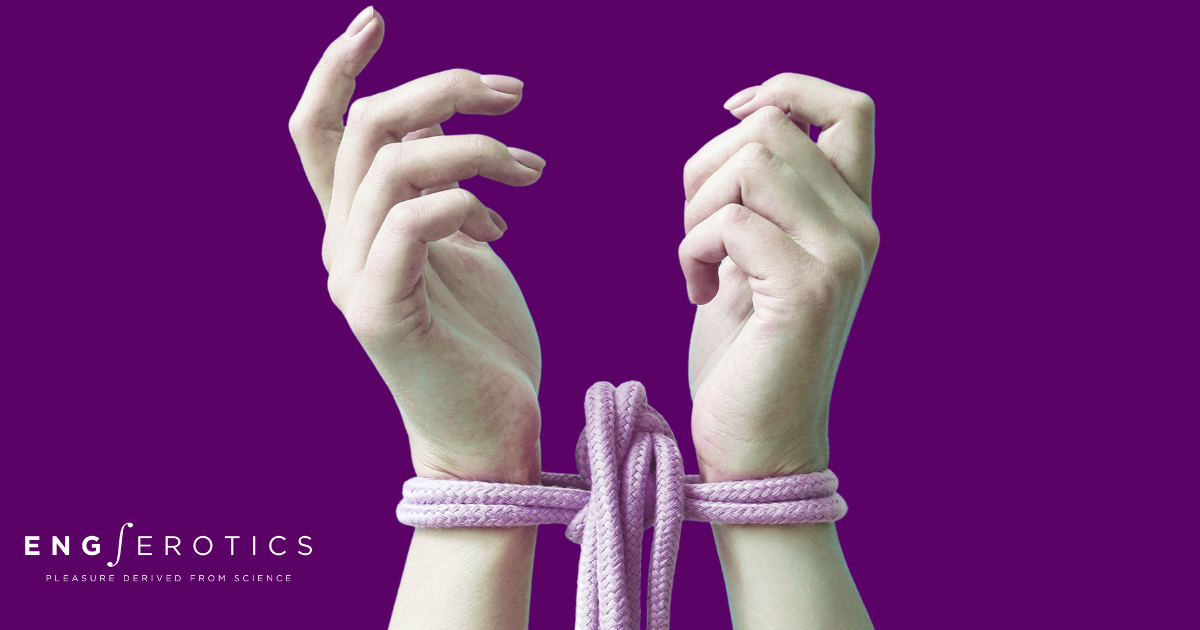Kink, or kinky sex, is considered anything sexually nontraditional. We would never yuck someone else’s yum (and we hope you wouldn’t either) – as long as the sex is consensual (and pleasurable!), we’re all for it!
BDSM is a type of kink; but there’s a very big difference between BDSM and abuse, and being kinky doesn’t obligate you to doing anything you don’t want to do.
I went back to the basics of BDSM in this previous blog post – but today, I want to go deeper. I want to talk about the difference between BDSM and abuse, because that distinction matters. A lot.
What is BDSM?
B – Bondage (Example: restraints, such as handcuffs)
D – Discipline (Example: the use of rules and consequences; typically seen in Dominant/Submissive roleplaying)
S – Sadism (Example: Enjoys giving intense sensations; does not have to be painful)
M – Masochism (Example: Enjoys receiving intense sensations; does not have to be painful)
First and foremost, it is important to recognize that BDSM is not about willfully hurting someone – it’s about consensual sensation, trust, and control. When practiced ethically and consensually, BDSM can be a form of intimacy that can be deeply empowering, pleasurable, and healing for many people.
BDSM often involves a consensual power exchange, where one person gives up some control in a safe environment – usually for a limited time, and always with the ability to stop. A BDSM dynamic is unique and can vary – some may prefer restraints and role play while others enjoy punishment and spanking. There is also no requirement to fulfill all the letters of BDSM at once – you may enjoy bondage without the masochism – it’s all about what you want and how you want it.
In the words of Rihanna, “…chains and whips excite me” 😉
BDSM (≠) Abuse
BDSM is NOT physical aggression or violence towards others – that’s abuse.
Abuse, by definition, involves a non-consensual power imbalance – one person exerting control over another through fear, guilt, intimidation, or violence. Abuse thrives on coercion and control – not communication and consent. In abusive dynamics, boundaries are crossed, and often there is no way to say “stop” without consequences.
Red Flags
If you’re exploring BDSM, here are some red flags that signal a relationship may be veering into abusive territory:
- You feel pressured to say yes or afraid to say no.
- Your safeword is ignored.
- Boundaries are crossed without discussion.
- Communication is met with guilt, blame, or punishment.
If any of these sound familiar, know this: You deserve safety, pleasure, and healthy sexual intimacy.

Boundaries
While communication is important for all sexual encounters, it becomes vital for those engaging in any BDSM play. Everything that occurs in a BDSM scene, must be discussed prior to the act. This is the time to talk through boundaries, limits, desires, and potential triggers before any act begins. Discuss what you want and want you don’t agree to, such as “I agree to… but I don’t agree to…”. In reality, it may sound more like, “I want you to tie me up, but I don’t want you to spank me this time”. This dialogue needs to be done by all individuals involved – this should not be a one-sided conversation. Consider this an agreed upon discussion that can be altered at any time.
In our previous blog, we reviewed the importance of safe words – pre-agreed signals that can stop the scene immediately if someone becomes uncomfortable or overwhelmed. When used properly, they’re a powerful tool of autonomy and trust. In scenes where a verbal safe word isn’t possible (for instance, because someone is gagged), partners will work out non-verbal safe words to ensure everyone’s boundaries are respected.
There is a common BDSM misconception that the power is only held by one person and the other individual has no input in the situation. However, in a healthy BDSM dynamic, all individuals have equal power and should feel heard, safe, and respected. To be dominant, does not mean that you ignore boundaries. To be submissive, does not mean that you accept anything and everything. There should always be trust, respect, and clearly established boundaries between everyone involved.
Consent
The crucial element of BDSM is consent. This is the differential factor between BDSM and abuse.
Exploring BDSM doesn’t mean foregoing consent entirely — consent is crucial in any and all sexual activity. In some BDSM scenes, there may be the illusion of surrender, control, or the element of surprise – though this is consensual and talked about during previously discussed boundaries. Before a single rope is tied or command is spoken, both (or all) parties involved must have clearly agreed on what will and will not happen. This isn’t a vague “sure, I guess.” It’s an enthusiastic, informed yes.
Want a quick reminder on what consent looks like? Our previous blog will bring you “Back to Basics”.
The big difference between BDSM and abuse is consent and respect. All people involved should understand what’s about to happen, express their boundaries, and be able to stop/revoke consent at any time.
In BDSM, consent isn’t optional – it’s everything.
BDSM Can Be Healing – Abuse Is Never Okay.
Many people explore BDSM as a way to reclaim their bodies, express deep trust, or even process past trauma in a consensual, controlled space. When done with care and intention, BDSM can be empowering and a source of healing. Abuse, on the other hand, leaves emotional scars and degrades one’s self-worth. It isolates rather than connects. It wounds rather than heals.
Quick reminders:
- If it’s not talked about, not agreed to, and not stoppable – it’s not kinky. It’s harmful.
- Remember to check in during to assess how each other are feeling.
- Aftercare – the emotional and physical support that follows a scene – is just as important as the play itself.
Our infamous Oh!Nectar Body Oil makes for a perfect aftercare sesh
You deserve pleasure that’s safe, consensual, and respected.
If you or someone you know is experiencing abuse, please reach out to a local domestic violence hotline or resource center. There is help. There is hope.





